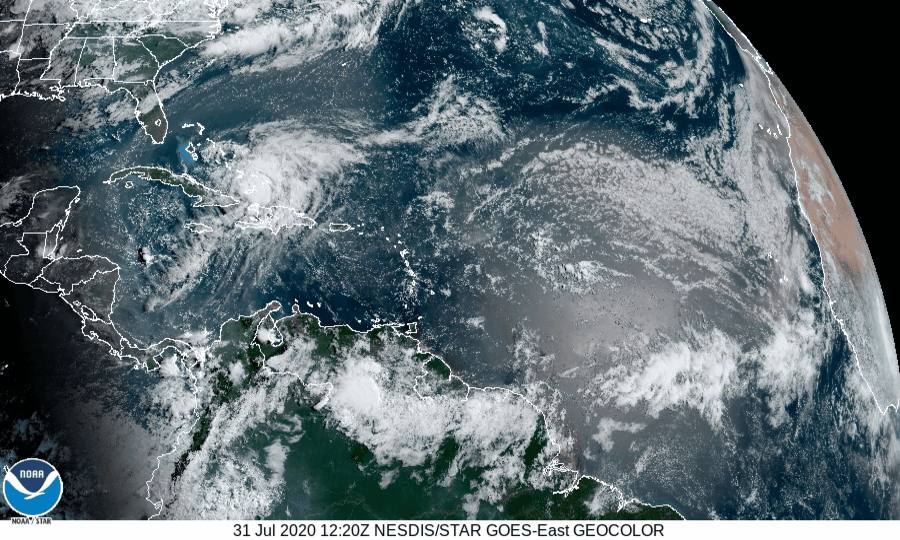
Isaias Menaces Bahamas and Florida as 2020 Season’s Second Hurricane

Satellite imagery of Isaias on July 31, 2020. CIRA / NOAA
Isaias, the earliest Atlantic “I” storm on record, strengthened into a Category 1 hurricane Thursday and now has the Bahamas and potentially Florida in its path.
As a tropical storm, Isaias has already battered Haiti, the Dominican Republic and Puerto Rico. In Puerto Rico, still recovering from 2017’s Hurricane Maria, the storm knocked out the power of 300,000 to 400,000 people, dumped five to 10 inches of rain and caused mudslides and flash flooding, National Weather Service San Juan meteorologist Gabriel Lojero told CNN. One woman went missing when her car was swept away.
“A lot of neighborhoods were submerged under water,” Lojero said.
Southwestern PR | Suroeste de PR:
Flash Flood Warning in effect until 9:15 pm.
Aviso de Inundaciones repentinas en efecto hasta las 9:15 pm. #prwx pic.twitter.com/ekw5jICXZn— NWS San Juan (@NWSSanJuan) July 30, 2020
The Dominican Republic also experienced flooding, water and power outages and storm damage, The Associated Press reported. One man died when he was electrocuted by a toppled electrical cable.
Isaias is now 340 miles from Nassau in the Bahamas with winds of 80 miles per hour, according to an 8 a.m. EDT update from the National Hurricane Center (NHC). Hurricane conditions are expected in parts of the Bahamas today.
The storm is expected to reach the central Bahamas tonight and move near or over the Northwestern Bahamas and near or east of the Florida peninsula Saturday and Sunday.
One of the major potential hazards from the storm is rain. It is expected to dump four to eight inches of rain on the Bahamas, the Dominican Republic, northern Haiti and the Turks and Caicos islands through Saturday and one to two inches over Cuba.
“These rainfall amounts will lead to life-threatening flash flooding and mudslides, as well as river flooding,” the NHC warned.
Between Friday and Monday, the storm could dump two to four inches over South and east-Central Florida, potentially causing flooding. Heavy rains could reach the Carolinas early next week.
Here are the Key Messages for July 31 at 5 am EDT for #Hurricane #Isaias. The full advisory is at https://t.co/tW4KeFW0gB pic.twitter.com/363SReR3tw
— National Hurricane Center (@NHC_Atlantic) July 31, 2020
Isaias has slowed somewhat as it approaches the Bahamas, from 22 miles per hour Wednesday to 17 on Friday. This means it will have more time to strengthen as it passes over warmer water, the Tampa Bay Times pointed out. This could spell trouble for the Bahamas, parts of which were devastated by Hurricane Dorian, which rapidly intensified last year.
“We know from past and recent experience that storms could change course very quickly,” Bahamas Prime Minister Hubert Minnis said during a press conference Thursday, as the Tampa Bay Times reported. “They can intensify rapidly as we saw with hurricane Dorian. So I ask all Bahamians and residents to take this storm seriously and to make preparations.”
Grand Bahama and Abaco, two of the islands in the Bahamas battered by Dorian, are also covered by the hurricane warning for Isaias, The Associated Press reported. People on both islands are still living in tents almost 11 months later.
(1/2) 🌀 11PM CDT: Latest on now Hurricane #Isaias. Here is a late-night infrared satellite view of the storm which has emerged off the coast of Hispaniola into warmer waters. Air Force Hurricane Hunters measured max winds of 80 mph in the storm. #lawx #mswx pic.twitter.com/2pzTBvDYyq
— NWS New Orleans (@NWSNewOrleans) July 31, 2020
It is still unclear if Isaias will make landfall in Florida, lash the Florida coast without making a direct hit as it moves towards the Carolinas, or veer off into the Atlantic.
However, the state is preparing, in part by closing some of its coronavirus testing sites, CNN reported.
The approaching hurricane comes as Florida reported almost 10,000 new COVID-19 cases Thursday, and the combination of the two hazards complicates the response to each.
“Look, if we have a major hurricane here, then we’re going to have to evacuate a number of people and then we’re going to have to … try to keep them separated as much as possible,” Miami-Dade County Mayor Carlos Giménez told CNN. “That’s a concern.”
Isaias is the second hurricane in an early and active Atlantic hurricane season. Hanna, which battered Texas last weekend, was both the season’s first hurricane and the earliest “H” storm on record.
A study published in May found that the climate crisis is making tropical storms stronger and wetter.
- Tropical Storm Warnings Issued for Puerto Rico, Eastern Caribbean ...
- Isaias Projected to Become Hurricane as it Approaches Carolinas - EcoWatch

 233k
233k  41k
41k  Subscribe
Subscribe 